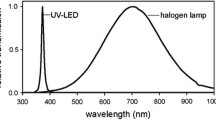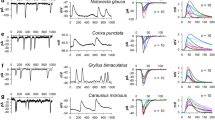Summary
The cross-sectional area of rhabdomeres in the compound eye of the blowfly, Lucilia, was found to remain constant under 12 h light/12 h dark cyclic lighting, and 10 days constant light or darkness. It was reduced only slightly during 3 h light after 10 days darkness (by 21%), or on exposure to 2h darkness + 1.5 h light after 10 days light (by 10%). Morphological evidence indicates that shedding of photoreceptor membrane during turnover is achieved by an extracellular route, and by pinocytosis from the bases of the microvilli. The photoreceptor membrane shed by both mechanisms appears to accumulate in multivesicular bodies. The amount of photoreceptor membrane shedding, as indicated by numbers of multivesicular bodies, is constant throughout the day and night on cyclic lighting, decreases in constant darkness, but returns to its normal level after an exposure to 3 h light subsequent to 10 days darkness.
Similar content being viewed by others
References
Basinger S, Hoffman R, Matthes M (1976) Photoreceptor shedding is initiated by light in the frog retina. Science 194:1074–1076
Battelle B-A, LaVail MM (1978) Rhodopsin content and rod outer segment length in albino rat eyes: modification by dark adaptation. Exp Eye Res 26:487–497
Besharse JC, Hollyfield JG, Rayborn ME (1977) Turnover of rod photoreceptor outer segments II. Membrane addition and loss in relationship to light. J Cell Biol 75:507–527
Blest AD (1978) The rapid synthesis and destruction of photoreceptor membrane by a dinopid spider: a daily cycle. Proc R Soc Lond B 200:463–483
Blest AD (1980) Photoreceptor membrane turnover in arthropods: comparative studies of breakdown processes and their implications. In: Williams TP, Baker BN (eds) The effects of constant light on visual processes. Plenum, New York, pp 217–245
Blest AD, Maples J (1979) Exocytotic shedding and glial uptake of photoreceptor membrane by a salticid spider. Proc R Soc Lond B 204:105–112
Blest AD, Stowe S, Eddey W, Williams DS (1982) The local deletion of a microvillar cytoskeleton from photoreceptors of tipulid flies during membrane turnover. Proc R Soc Lond B (in press)
Boschek BC (1971) On the fine structure of the peripheral retina and lamina ganglionaris of the fly, Musca domestica. Z Zellforsch 118:369–409
Currie JR, Hollyfield JG, Rayborn ME (1978) Rod outer segments elongate in constant light: darkness is required for normal shedding. Vision Res 18:995–1003
Dietrich W (1909) Die Facettenaugen der Dipteren. Z wiss Zool 92:463–539
Eguchi G, Waterman TH (1967) Changes in retinal fine structure induced in the crab Libinia by light and dark adaptation. Z Zellforsch 79:209–229
Eguchi G, Waterman TH (1976) Freeze-etch and histochemical evidence for cycling in crayfish photoreceptor membranes. Cell Tissue Res 169:419–434
Ito S (1965) The enteric surface coat on cat intestinal microvilli. J Cell Biol 27:475–491
Kirschfeld K, Snyder AW (1975) Waveguide mode effects, birefringence, and dichroism in fly photoreceptors. In: Snyder AW, Menzel R (eds) Photoreceptor Optics. Springer, Berlin Heidelberg New York, pp 56–57
Martin RL, Hafner GS (1981) Uptake of ultrastructural tracers by crayfish photoreceptors. Invest Ophthal Vis Sci 20 (ARVO suppl):75
Nässel DR, Waterman TH (1979) Massive diurnally modulated photoreceptor membrane turnover in crab light and dark adaptation. J Comp Physiol 131:205–216
Pask C, Snyder AW (1975) Angular sensitivity of lens-photoreceptor systems. In: Snyder AW, Menzel R (eds) Photoreceptor Optics. Springer, Berlin Heidelberg New York, pp 159–166
Schneider L, Langer H (1966) Die Feinstruktur des Überganges zwischen Kristallkegel und Rhabdomeren im Facettenauge von Calliphora. Z Naturforsch 21 b:196–197
Snyder AW, Miller WH (1972) Fly colour vision. Vision Res 12:1389–1396
Snyder AW, Pask C (1973) Spectral sensitivity of dipteran retinula cells. J Comp Physiol 84:59–76
Stavenga DG (1975) Optical qualities of the fly eye — an approach from the side of geometrical, physical and waveguide optics. In: Snyder AW, Menzel R (eds) Photoreceptor optics. Springer, Berlin Heidelberg New York, pp 126–144
Stowe S (1980) Rapid synthesis of photoreceptor membrane and assembly of new microvilli in a crab at dusk. Cell Tissue Res 211:419–440
Stowe S (1981) Effects of illumination changes on rhabdom synthesis in a crab. J Comp Physiol 142:19–25
Suzuki K (1962) Polyphenolic derivatives in rhabdomeres of the compound eye. Nature 196:994
Trujillo-Cenóz O, Melamed J (1966) Electron microscope observations on the peripheral and intermediate retinas of dipterans. In: Bernhard CG (ed) The functional organization of the compound eye. Pergamon, London, pp 339–361
White RH (1968) The effect of light and light deprivation upon the ultrastructure of the larval mosquito eye. III. Multivesicular bodies and protein uptake. J Exp Zool 169:261–278
White RH, Michaud NA (1981) Disruption of insect photoreceptor membrane by divalent ions: dissimilar sensitivity of light-, and dark-adapted mosquito. Cell Tissue Res 216:403–411
White RH, Gifford D, Michaud NA (1980) Turnover of photoreceptor membrane in the larval mosquito ocellus: rhabdomeric coated vesicles and organelles of the vacuolar system. In: Williams TP, Baker BN (eds) The effects of constant light on visual processes. Plenum, New York, pp 271–296
Wijngaard W, Stavenga DG (1975) On optical crosstalk between fly rhabdomeres. Biol Cybern 18:61–67
Williams DS (1980a) Ca++-induced structural changes in photoreceptor microvilli of Diptera. Cell Tissue Res 206:225–232
Williams DS (1980b) Organisation of the compound eye of a tipulid fly during the day and night. Zoomorphologie 95:85–104
Williams DS (1982) Ommatidial structure in relation to turnover of photoreceptor membrane in the locust. Cell Tissue Res 225:595–617
Williams DS, Blest AD (1980) Extracellular shedding of photoreceptor membrane in the open rhabdom of a tipulid fly. Cell Tissue Res 205:423–438
Young RW (1976) Visual cells and the concept of renewal. Invest Ophthal Vis Sci 15:700–725
Author information
Authors and Affiliations
Rights and permissions
About this article
Cite this article
Williams, D.S. Rhabdom size and photoreceptor membrane turnover in a muscoid fly. Cell Tissue Res. 226, 629–639 (1982). https://doi.org/10.1007/BF00214790
Accepted:
Issue Date:
DOI: https://doi.org/10.1007/BF00214790




